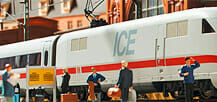Class 193 Electric Locomotive
For the Birthday
Visions in Metal
Theodor Friedrich Wilhelm Märklin
*2. April 1817 † 20 December 1866
When little Theodor Friedrich Wilhelm first saw the light of day on April 2, 1817 in Tieringen near Balingen, Germany, no one could have suspected that later he would become the founder of one of the most famous toy firms in the world.
Yet with the abilities that he accumulated from his apprenticeship as a tinsmith, and the vision to create something new, in 1859 he founded a firm that not only produced the usual cookware and tableware but also miniaturized reproductions of the same. The functional doll kitchens produced by him prepared young ladies in society for their as yet still firmly defined role as housewife and mother in the 19th century.
His marriage to this second wife (née Hettich) was in hindsight a blessing for Th. Fr. Wilh. Märklin and the further development of the firm Märklin. Not only that she supported him in the further development and the sale of girls' tin-plate toys in what was an unusual way for the times. She also took on the difficult task after the sudden death of her husband on December 20, 1866 of managing the business until her sons Karl and Eugen were old enough to establish the business "Gebrüder Märklin" / "Märklin Brothers" and ultimately plunge into the world of railroad models.
The entire business would like to bow to the company's founder with the Märklin model 36187 "200 Jahre TFW Märklin" / "200 Years of TFW Märklin" bring together his ingenious ideas and today's "high-tech" model trains which probably would not be here without him.
Prototype: "Vectron" class 193 electric locomotive. Painted and lettered with special designed Märklin look.
Most Important Facts
Sound demo| Article No. | 36187 |
|---|---|
| Gauge / Design type | H0 / 1:87 |
| Era | VI |
| Kind | Electric Locomotives |
Check with your local dealer Find Dealer
Highlights
- 200th birthday of Theodor Friedrich Wilhelm Märklin 1817 - 2017.
- Limited worldwide to 1,817 pieces.
- Locomotive includes a built-in mfx decoder and a variety of light and sound functions.
- Detailed, affordable beginner model with extensive features.
-
Product description
Model: The locomotive is constructed of metal and has an mfx digital decoder and extensive sound functions. It also has a special motor, centrally mounted. 4 axles powered through cardan shafts. Traction tires. Triple headlights and dual red marker lights change over with the direction of travel, will work in conventional operation, and can be controlled digitally. The headlights at Locomotive End 2 and 1 can be turned off separately in digital operation. When the headlights at both ends of the locomotive are turned off, then the double "A" light function is on at both ends. Maintenance-free, warm white and red LEDs are used for the lighting. The locomotive has 2 mechanically working pantographs (no electrical pickup from catenary).
Length over the buffers 21.8 cm / 8-9/16".Find more Märklin explanation videos on our YouTube Channel
Spare parts for our articles can be found here in our spare parts search.
This model is being issued in a one-time series for the 200th birthday of Theodor Friedrich Wilhelm Märklin and is limited worldwide to 1,817 pieces.
-
Publications
- Fall New Items 2017 - Product programme 2017/2018
-
Digital Functions
Control Unit Mobile Station Mobile Station 2 Central Station 1/2 Central Station 3/2*
Mobile Station 2**Headlight(s) Operating Sounds 1 Electric locomotive op. sounds Low Pitch Horn Direct control Sound of squealing brakes off Headlight(s): Cab2 End High Pitch Horn Headlight(s): Cab1 End Sound of Couplers Engaging Operating Sounds 2 Letting off Air Blower motors Conductor's Whistle Rail Joints * New features of the Central Station 2 (Part No. 60213, 60214 or 60215) with the software update 4.2
** New features of the Mobile Station 2 (Part No. 60657/66955) with the Software Update 3.55









